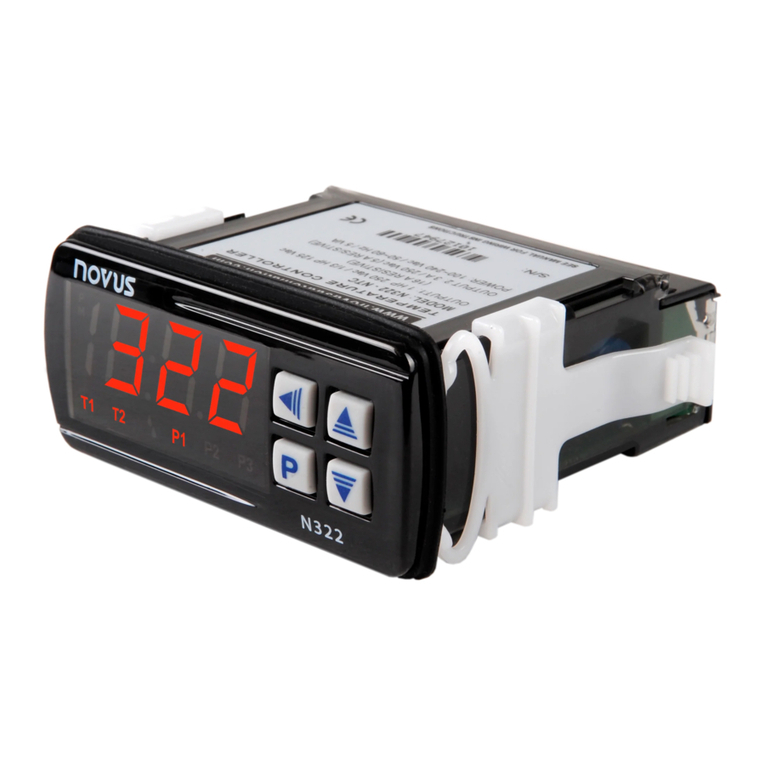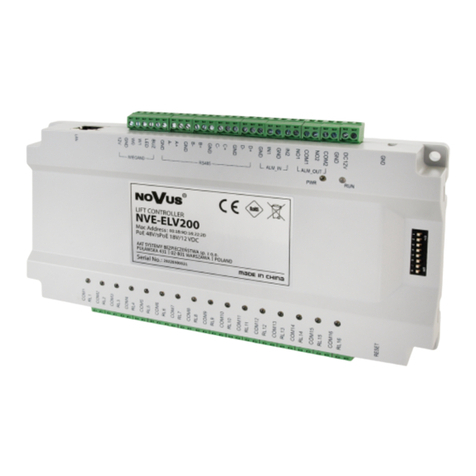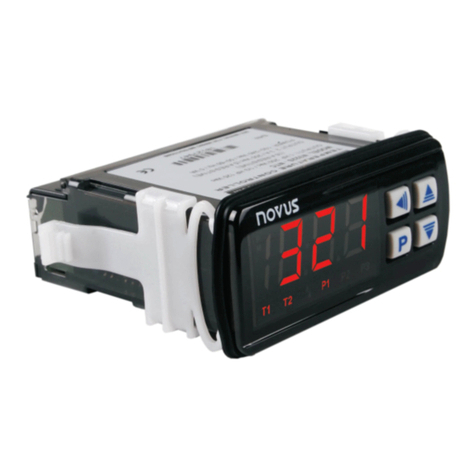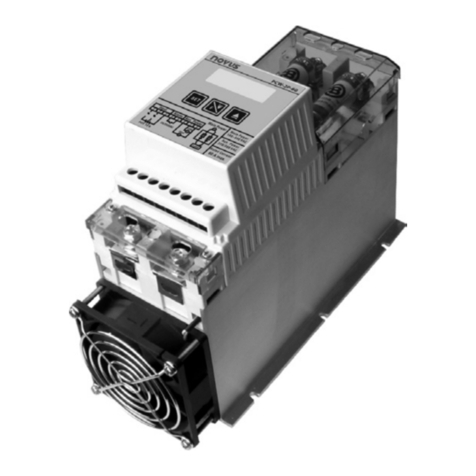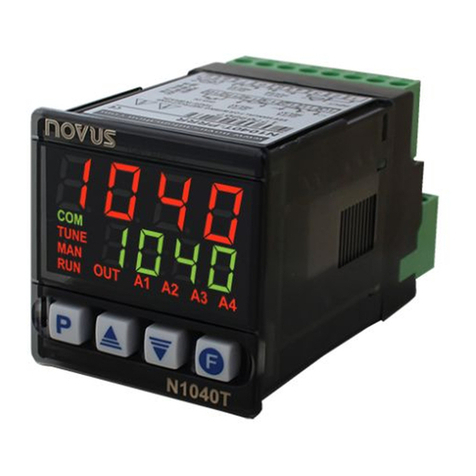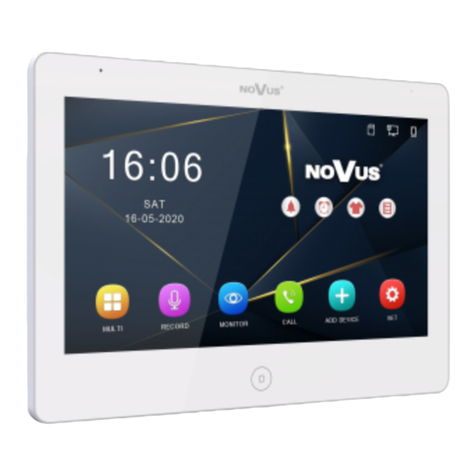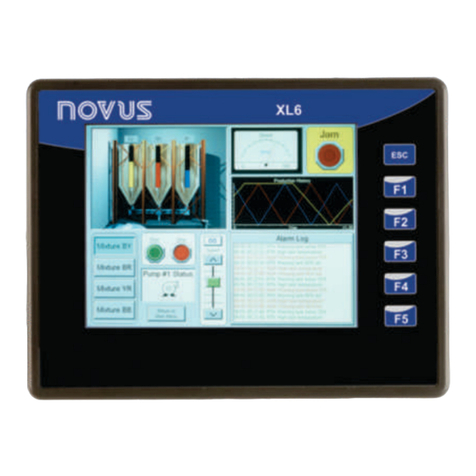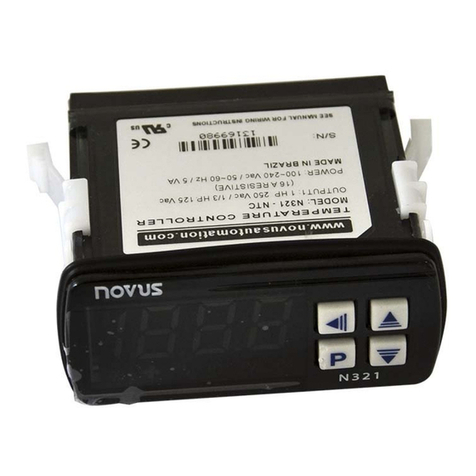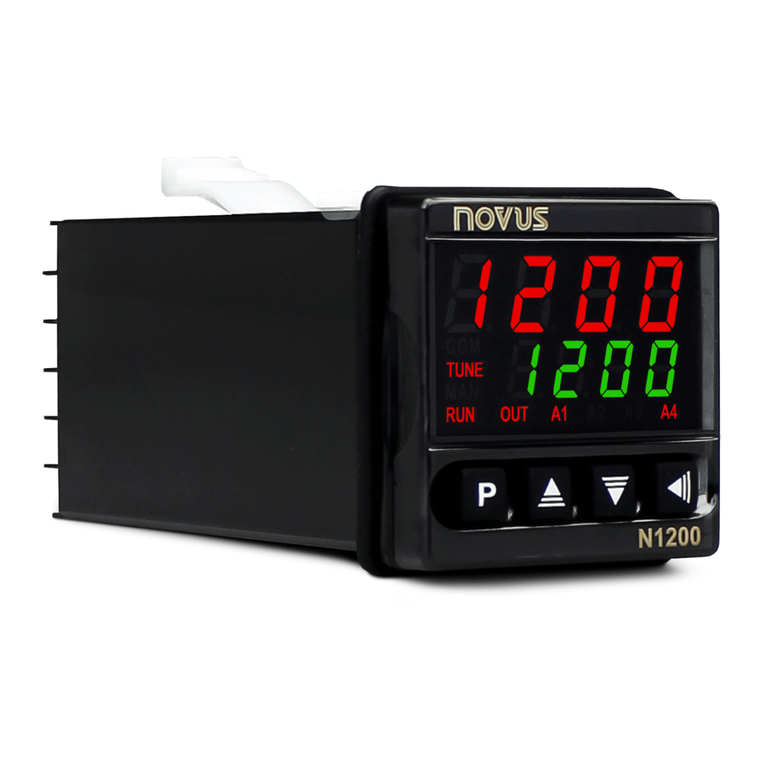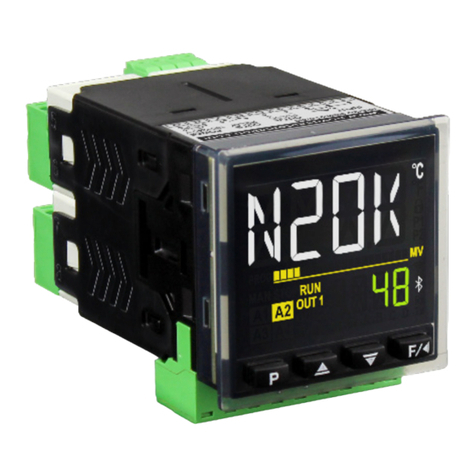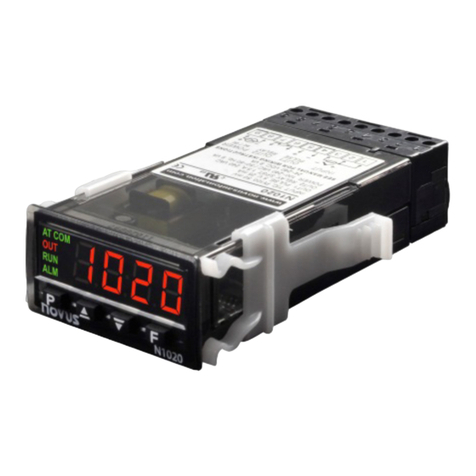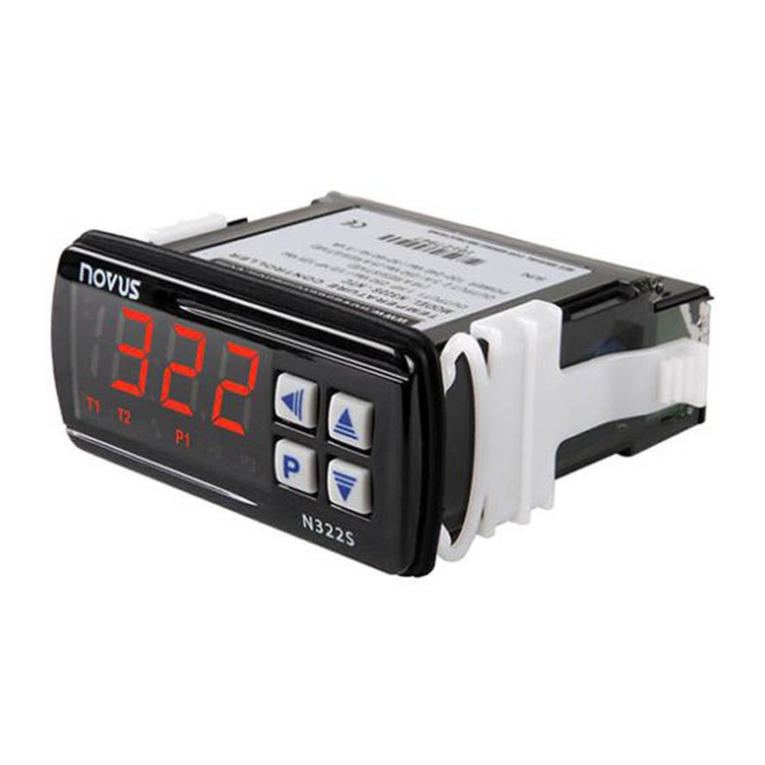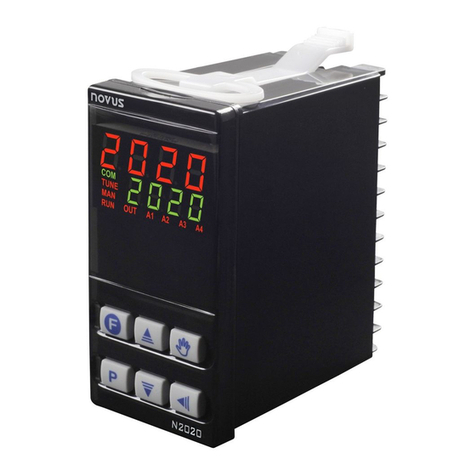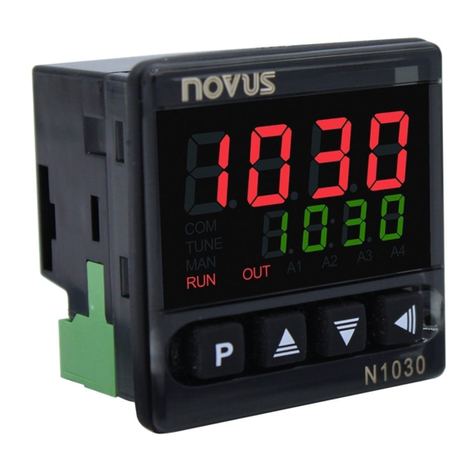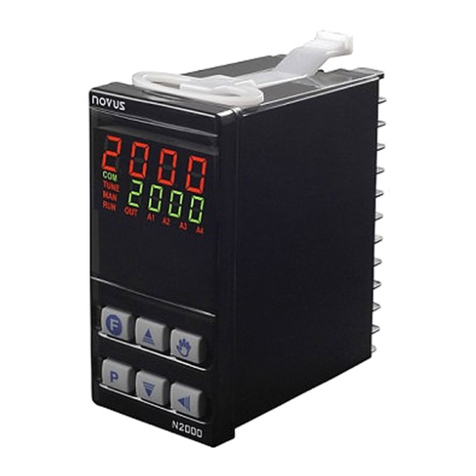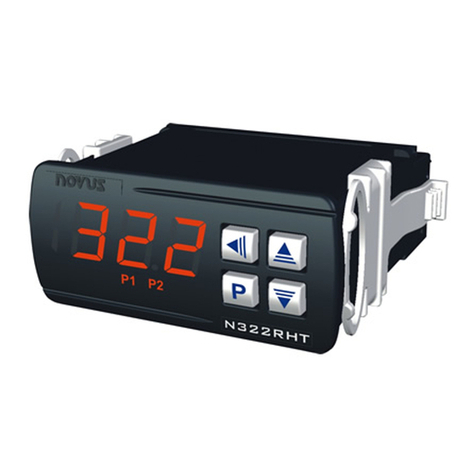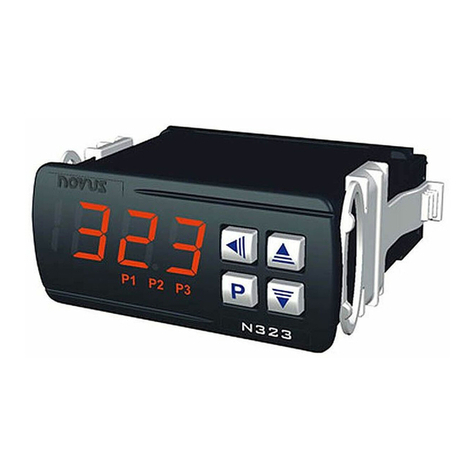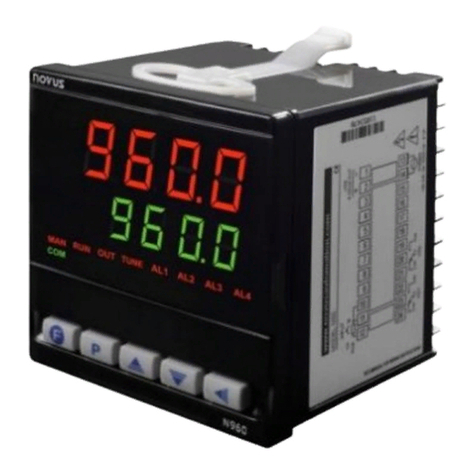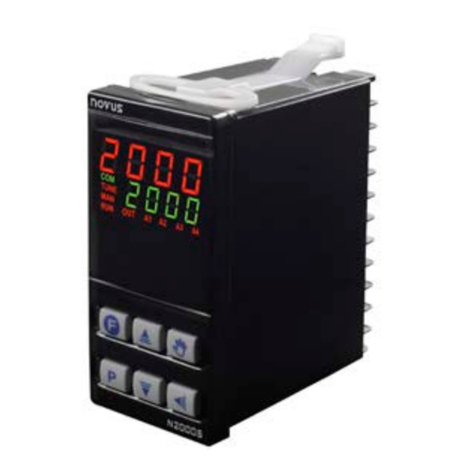
Controller N3000
NOVUS AUTOMATION
8/9
ANALOG OUTPUT CALIBRATION
1. Select type 11 or 12 at the I/O5 prompt.
2. Connect a current meter at the analog output.
3. Disable the auto-tune and soft-start functions.
4. Set the output low limit ovLL
ovLLovLL
ovLL to 0.0 % and the output high limit
ovkL
ovkLovkL
ovkL to 100.0 %.
5. Select the manual mode at the avto
avtoavto
avto prompt.
6. Enable the output at the rvn
rvnrvn
rvn prompt.
7. t the operation cycle, set the MV to 0.0 %.
8. t the output low calibration ovLC
ovLCovLC
ovLC prompt, press the and
key until the m meter reads zero m . pproach this value
from above.
9. Set 100.0 % for the manipulated variable (MV).
10. t the output high calibration ovkC
ovkCovkC
ovkC prompt, press the and
key until the m meter reads 20 m . pproach this value
from below.
11. Repeat steps 7. to 10. as necessary.
PROBLEMS WITH THE CONTROLLER
Connection errors or improper configuration will result in malfunctioning
of the controller. Carefully revise all cable connections and programming
parameters before operating the unit.
Some error messages will help the user identify possible problems.
MESSAGE POSSIBLE PROBLEM
-----
----------
-----
Open input. No sensor is connected or the sensor is
broken.
Err1
Err1Err1
Err1
Err6
Err6Err6
Err6
Pt100 cable resistance is too high or the sensor is badly
connected.
Different messages other than the ones above should be reported to
the manufacturer. Please inform the serial number if this should
occur. The serial number can be viewed at the display by pressing
the key for about 3 seconds.
The software version of the instrument can be viewed at the time the
unit is powered.
When not properly configured, the instrument may show false error
messages, particularly those related to the type of input selected.
The controller also has a visual alarm (the display flashes) when the
PV value is out of the range set by spxl
spxlspxl
spxl and spll
spllspll
spll.
SERIAL COMMUNICATION
The indicator can be supplied with an asynchronous RS-485 digital
communication interface for master-slave connection to a host
computer (master).
The indicator works as a slave only and all commands are started by
the computer which sends a request to the slave address. The
addressed unit sends back the requested reply.
Broadcast commands (addressed to all indicator units in a multidrop
network) are accepted but no reply is sent back in this case.
CHARACTERISTICS
•RS-485 compatibility with two-wire connection from the host to up
to 31 slaves in a multidrop network topology. Up to 247 units can
be addressed by the MODBUS RTU protocol. Maximum network
distance: 4,000 feet. Time of indicator disconnection: Maximum of
2 ms after the last byte.
•Te communication signals are electrically isolated from the rest of
the instrument, and can be 1200, 2400, 4800, 9600, 19200, 38400,
and 57600 bps.
•Number of data bits: 8, without parity or pair parity
•Number of stop bits: 1
•Time to start response transmission: up to 100 ms after
acknowledging the command.
•Protocol: MODBUS (RTU)
RS485 INTERFACE: ELECTRICAL CONNECTION
The RS-485 signals are:
D1
D D +
B Bidirectional data line Terminal 25
D0
D:
D -
A Inverted bidirectional data line Terminal 26
C
GND
Optional connection to improve
communication performance
Terminal 27
SPECIFICATIONS
DIMENSIONS: ................. 96 x 96 x 92 mm. Peso proximado: 350 g
TERMINAL CONECCTION: ..... 24 screws acceping 6.3 mm fork lugs
PANEL CUT-OUT: ...................................93 x 93 mm (+0.5 -0.0 mm)
POWER:..................................... 100 a 240 Vac/dc (±10 %), 50/60 Hz
Optional: ............................................................ 24 Vac/dc ±10 %
Max. Consumption:................................................................ 9 V
ENVIRONMENTAL CONDITIONS:....................................... 5 a 50 ºC
Relative humidity (maximum): .............................80 % up to 30 ºC
.................... For temperatures above 30 ºC, decrease 3 % per ºC
....... Installation category II. Pollution degree 2. ltitude < 2000 m
INPUT.................... Keyboard selection of input type (refer to Table 1)
Internal resolution: .................................................. 19500 levels
Display resolution: .................12000 levels (from -1999 to 9999)
Input sample rate:....................................................5 per second
Accuracy: ..........Thermocouples J, K e T: 0.25 % of span ±1 ºC
.............................Thermocouples N, R, S: 0.25 % do span ±3 ºC
...................................................................... Pt100: 0.2 % of span
....................................4-20 m , 0-50 mV, 0-5 Vdc: 0.2 % of span
Input impedance:. 0-50 mV, Pt100 and thermocouples: >10 MΩ
................................................................................. 0-5 V: >1 MΩ
.................................................4-20 m : 15 Ω (+2 Vdc @ 20 m )
Pt100 measurement:................................... standard (=0.00385)
Excitation current:.................................0,170 m . 3-wire circuit,
cable resistance compensation.
ll input types are factory calibrated according to IEC-584 for
thermocouples and IEC-751 for Pt100.
DIGITAL INPUT (I/O6): .................. Dry contact or NPN open collector
ANALOG OUTPUT (I/O5):..............0-20 m or 4-20 m , 550 Ω max.
1500 levels, Isolated, para controle ou retransmissão de PV e SP
.....................................Control output or PV or SP retransmission
CONTROL OUTPUT: 2 Relays SPDT (I/O1 and I/O2): 3 / 240 Vac
2 Relays SPST-N (I/O3 and I/O4): 1,5 / 250 Vac
Logic pulse for SSR drive (I/O5): 10 V max / 20 m
SECOND ANALOG INPUT: 4-20 m remote set point (standard).
EMC:................................EN 61326-1:1997 and EN 61326-1/ 1:1998
SAFET : ...........................EN61010-1:1993 and EN61010-1/ 2:1995
Back panel: IP65, Polycarbonate UL94 V-2; Box: IP30, ABS+PC
UL94 V-0
Programmable PWM cycle from 0.5 seconds and 100 seconds;
Start up 3 seconds after power up.
ORDERING INFORMATION:
N3000 - 485 - 24V
A B C
A: Series model: N3000;
B: Digital communication: blank
485 (RS485, Modbus protocol)
C: Voltage rating: blank (100 to 240 Vac);
24V (24 Vac/dc);

